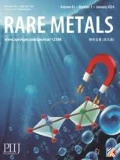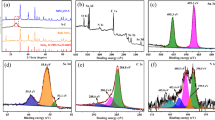Abstract
SnO2 is considered to be a promising candidate as anode material for lithium ion batteries, due to its high theoretical specific capacity (1494 mAh·g−1). Nevertheless, SnO2-based anodes suffer from poor electronic conductivity and serious volume variation (300%) during lithiation/delithiation process, leading to fast capacity fading. To solve these problems, SnO2 quantum dots modified N-doped carbon spheres (SnO2 QDs@N–C) are fabricated by facile hydrolysis process of SnCl2, accompanied with the polymerization of polypyrrole (PPy), followed by a calcination method. When used as anodes for lithium ion batteries, SnO2 QDs@N–C exhibits high discharge capacity, superior rate properties as well as good cyclability. The carbon matrix completely encapsulates the SnO2 quantum dots, preventing the aggregation and volume change during cycling. Furthermore, the high N content produces abundant defects in carbon matrix. It is worth noting that SnO2 QDs@N–C shows excellent capacitive contribution properties, which may be due to the ultra-small size of SnO2 and high conductivity of the carbon matrix.
Graphic abstract

SnO2 quantum dots modified N-doped carbon spheres are successfully fabricated by facile hydrolysis-high temperature calcination approach using SnCl2 and pyrrole monomer as precursors. As anodes for lithium ion batteries, the SnO2 QDs@N-C-600 exhibits superior rate capability and excellent cycling stability. This work provides an effective way to obtain electrode materials with high specific capacity and good cycling performance for energy storage





Similar content being viewed by others
References
Zou G, Hou H, Ge P, Huang Z, Zhao G, Yin D, Ji X. Metal-organic framework derived materials for sodium energy storage. Small. 2018;14(3):1702648.
Sun L, Ma T, Zhang J, Guo X, Yan C, Liu X. Double-shelled hollow carbon spheres confining tin as high performance electrodes for lithium ion batteries. Electrochim Acta. 2019;321:134672.
Han Y, Huang G, Xu S. Structural reorganization–based nanomaterials as anodes for lithium-ion batteries: design, preparation, and performance. Small. 2019;16(15):1902841.
Kim AY, Ardhi REA, Liu G, Kim GY, Shin HJ, Byun D, Lee JK. Hierarchical hollow dual core-shell carbon nanowall-encapsulated p-n SnO/SnO2 heterostructured anode for high-performance lithium-ion-based energy storage. Carbon. 2019;153:62.
Zhang Y, Xia X, Liu B, Deng S, Xie D, Liu Q, Wang Y, Wu J, Wang X, Tu J. Multiscale graphene-based materials for applications in sodium ion batteries. Adv Energy Mater. 2019;9(8):1803342.
Han X, Li R, Qiu S, Zhang X, Zhang Q, Yang Y. Sonochemistry-enabled uniform coupling of SnO2 nanocrystals with graphene sheets as anode materials for lithium-ion batteries. RSC Adv. 2019;9(11):5942.
Du X, Yang T, Lin J, Feng T, Zhu J, Lu L, Xu Y, Wang J. Microwave-assisted synthesis of SnO2@polypyrrole nanotubes and their pyrolyzed composite as anode for lithium-ion batteries. ACS Appl Mater Interfaces. 2016;8(24):15598.
Huang S, Wang W, Chen D, Hu Z, Jiang Y, Chen Z, Li Z, Pan D, Zhao B. Enhancing lithium-ion batteries performance via electron-beam irradiation strategies: a case study of graphene aerogels loaded with SnO2 quantum dots. Electrochim Acta. 2018;281(10):769.
Li B, Yan Y, Shen C, Yu Y, Wang Q, Liu M. Extraordinary lithium ion storage capability achieved by SnO2 nanocrystals with exposed {221} facets. Nanoscale. 2018;10(34):16217.
Wu SJ, Wu ZH, Fang S, Qi SP, Yu B, Yang JY. A comparison of core-shell Si/C and embedded structure Si/C composites as negative materials for lithium-ion batteries. Rare Metal. 2019. https://doi.org/10.1007/s12598-019-01354-8.
Zhang W, Sheng JZ, Zhang J, He T, Hu L, Wang R, Mai LQ, Mu SC. Hierarchical three-dimensional MnO nanorods/carbon anodes for ultralong-life lithium-ion batteries. J Mater Chem A. 2016;4(43):16936.
Yang JL, Hu L, Zheng JX, He DP, Tian LL, Mu SC, Pan F. Li2FeSiO4 nanorods bonded with graphene for high performance batteries. J Mater Chem A. 2015;3(18):9601.
Zhang Q, Liao J, Liao M, Dai J, Ge H, Duan T, Yao W. One-dimensional Fe7S8@C nanorods as anode materials for high-rate and longlife lithium-ion batteries. Appl Surf Sci. 2019;473:799.
Yao Y, Xiao Z, Liu P, Zhang S, Niu Y, Wu H, Liu S, Tu W, Luo Q, Sial MAZG. Facile synthesis of 2D ultrathin and ultrahigh specific surface hierarchical porous carbon nanosheets for advanced energy storage. Carbon. 2019;155:674.
Li L, Ye M, Ding Y, Xie D, Yu D, Hu Y, Chen HY, Peng S. Controlled synthesis of porous CaCo2O4 nanoflowers and their multifunctional applications for lithium ion batteries and oxygen evolution reaction. J Alloy Compd. 2020;812:152099.
Huang M, Feng M, Li H, Huang P, Su Q, Zhang F, Du G. Rapid microwave-assisted synthesis of SnO2 quantum dots/reduced graphene oxide composite with its application in lithium-ion battery. Mater Lett. 2017;209:260.
Wang J, Wang J, Han L, Liao C, Cai W, Kan Y, Hu Y. Fabrication of an anode composed of a N, S codoped carbon nanotube hollow architecture with CoS2 confined within: toward Li and Na storage. Nanoscale. 2019;11(43):20996.
Kumar R, Sahoo S, Joanni E, Singh RK, Tan WK, Kar KK, Matsuda A. Recent progress in the synthesis of graphene and derived materials for next generation electrodes of high performance lithium ion batteries. Prog Energ Combust. 2019;75:100786.
Yan Z, Yang Q, Wang Q, Ma J. Nitrogen doped porous carbon as excellent dual anodes for Li- and Na-ion batteries. Chinese Chem Lett. 2020;31(2):583.
Wang Q, Zhang W, Guo C, Liu Y, Wang C, Guo Z. In situ construction of 3D interconnected FeS@Fe3C@graphitic carbon networks for high-performance sodium-ion batteries. Adv Funct Mater. 2017;27(41):1703390.
Liu Y, Yan Y, Li K, Yu Y, Wang Q, Liu M. A high-areal-capacity lithium-sulfur cathode achieved by a boron-doped carbon–sulfur aerogel with consecutive core-shell structures. Chem Commun. 2019;55(8):1084.
Liu M, Yang Z, Sun H, Lai C, Zhao X, Peng H, Liu T. A hybrid carbon aerogel with both aligned and interconnected pores as interlayer for high-performance lithium–sulfur batteries. Nano Res. 2016;9(12):3735.
Liu M, Zhang P, Qu Z, Yan Y, Lai C, Liu T, Zhang S. Conductive carbon nanofiber interpenetrated graphene architecture for ultra-stable sodium ion battery. Nat Commun. 2019;10(1):1.
Yang Z, Zhang P, Wang J, Yan Y, Yu Y, Wang Q, Liu M. Hierarchical carbon@SnS2 aerogel with “skeleton/skin” architectures as a high-capacity, high-rate capability and long cycle life anode for sodium ion storage. ACS Appl Mater Interfaces. 2018;10(43):37434.
Dong Y, Feng Y, Deng J, He P, Ma J. Electrospun Sb2Se3@C nanofibers with excellent lithium storage properties. Chinese Chem Lett. 2020; 31(3):909.
Hu R, Sun W, Liu H, Zeng M, Zhu M. The fast filling of nano-SnO2 in CNTs by vacuum absorption: a new approach to realize cyclic durable anodes for lithium ion batteries. Nanoscale. 2013;5(23):11971.
Liu H, Zhang X, Zhu Y, Cao B, Zhu Q, Zhang P, Xu B, Wu F, Chen R. Electrostatic self-assembly of 0D–2D SnO2 quantum dots/Ti3C2Tx MXene hybrids as anode for lithium-ion batteries. Nano-Micro Lett. 2019;11(1):65.
Ren L, Yao Y, Wang K, Li S, Zhu K, Liu J. Novel one-step in situ growth of SnO2 quantum dots on reduced graphene oxide and its application for lithium ion batteries. J Solid State Chem. 2019;273:128.
Cheng Y, Huang J, Qi H, Cao L, Luo X, Li J, Xu Z, Yang J. Controlling the Sn-C bonds content in SnO2@CNTs composite to form in-situ pulverized structure for enhanced electrochemical kinetics. Nanoscale. 2017;9(47):18681.
Yang H, Xu R, Yao Y, Ye S, Zhou X, Yu Y. Multicore-shell Bi@N-doped carbon nanospheres for high power density and long cycle life sodium- and potassium-ion anodes. Adv Funct Mater. 2019;29(13):1809195.
Xu C, Niu D, Zheng N, Yu H, He J, Li Y. Facile synthesis of nitrogen-doped double-shelled hollow mesoporous carbon nanospheres as high-performance anode materials for lithium ion batteries. ACS Sustain Chem Eng. 2018;6(5):5999.
Dai R, Sun W, Wang Y. Ultrasmall tin nanodots embedded in nitrogen-doped mesoporous carbon: metal-organic-framework derivation and electrochemical application as highly stable anode for lithium ion batteries. Electrochim Acta. 2016;217:123.
Xu Y, Zhang C, Zhou M, Fu Q, Zhao C, Wu M, Lei Y. Highly nitrogen doped carbon nanofibers with superior rate capability and cyclability for potassium ion batteries. Nat Commun. 2018;9(1):1720.
Zhu C, Wei D, Wu Y, Zhang Z, Zhang G, Duan J, Li L, Zhu H, Zhu Z, Chen Z. Controllable construction of interconnected SnOx/N-doped carbon/carbon composite for enhanced-performance lithium-ion batteries anodes. J Alloy Compd. 2019;778:731.
Yuan J, Hao Y, Zhang X, Li X. Sandwiched CNT@SnO2@PPy nanocomposites enhancing sodium storage. Colloids Surf A. 2018;555:795.
Wang Y, Jin YH, Zhao CC, Duan YH, He XZ, Jia MQ. SnO2 quantum dots/graphene aerogel composite as high-performance. Anode material for sodium ion batteries. Mat Lett. 2017;191:169.
Xia SB, Yao LF, Guo H, ShenX LJM, Cheng FX, Liu JJ. Li+ intercalcation pseudocapacitance in Sn-based metal-organic frameworkfor high capacity and ultra-stable Li ion storage. J Power Sources. 2019;440:227162.
Liu X, Chao D, Li Y, Hao J, Liu X, Zhao J, Lin J, Fan HJ, Shen ZX. A low-cost and one-step synthesis of N-doped monolithic quasi-graphene films with porous carbon frameworks for Li-ion batteries. Nano Energy. 2015;17:43.
Lu J, Xia G, Gong S, Wang C, Jiang P, Lin Z, Wang D, Yang Y, Chen Q. Metallic 1T phase MoS2 nanosheets decorated hollow cobalt sulfide polyhedrons for high-performance lithium storage. J Mater Chem A. 2018;6(26):12613.
He J, Shen L, Wu C, Guo C, Wang Q, Liu Z, Yang S, Wang Q. Rational design of Ni/Ni2P heterostructures encapsulated in 3D porous carbon networks for improved lithium storage. Dalton T. 2019;48(42):16000.
Wang Q, Zhu Y, Xue J, Zhao X, Guo Z, Wang C. General synthesis of porous mixed metal oxide hollow spheres with enhanced supercapacitive properties. ACS Appl Mater Interfaces. 2016;8(27):17226.
Acknowledgements
This work was financially supported by the National Natural Science Foundation of China (Nos. 51702138 and 21817056), the Natural Science Foundation of Jiangsu Province (Nos .BK20160213 and BK20170239) and the Postgraduate Research & Practice Innovation Program of Jiangsu Province (No. KYCX20-2358).
Author information
Authors and Affiliations
Corresponding authors
Electronic supplementary material
Below is the link to the electronic supplementary material.
Rights and permissions
About this article
Cite this article
Wu, CP., Xie, KX., He, JP. et al. SnO2 quantum dots modified N-doped carbon as high-performance anode for lithium ion batteries by enhanced pseudocapacitance. Rare Met. 40, 48–56 (2021). https://doi.org/10.1007/s12598-020-01623-x
Received:
Revised:
Accepted:
Published:
Issue Date:
DOI: https://doi.org/10.1007/s12598-020-01623-x



